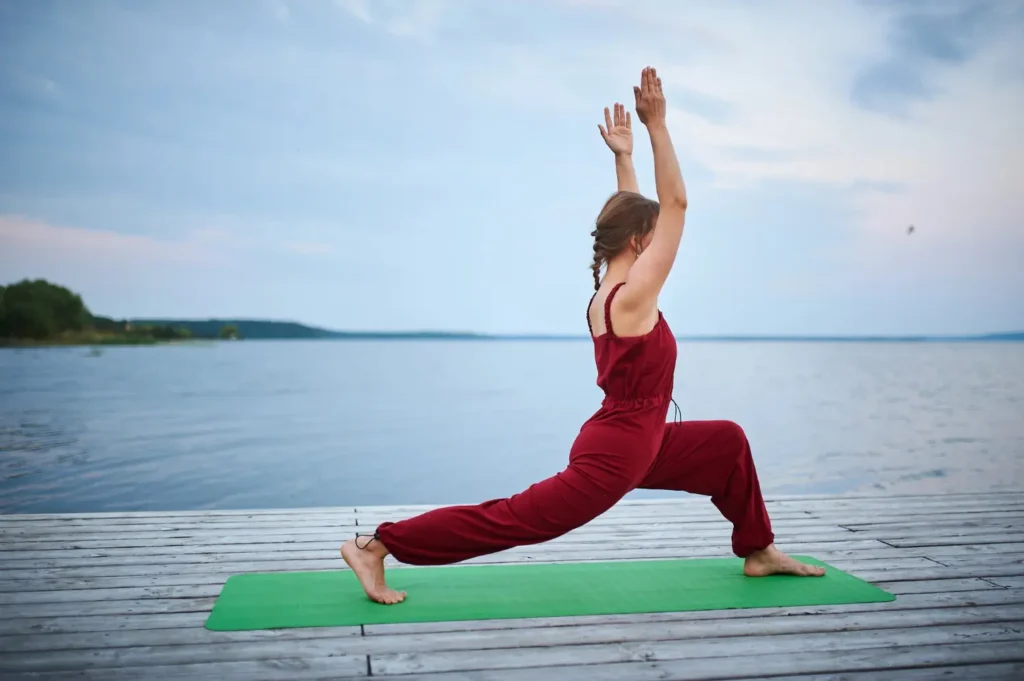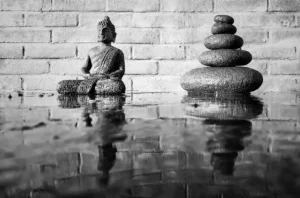Table of Contents
ToggleThe ancient art of Yoga creates harmony between the body, mind, and spirit through mindful movement, regulation of breath, meditation, and self-awareness. Yoga evolved from the philosophy of the Patanjali Yoga Sutras, and it has eight limbs; Asana is the third limb. The word “Yoga” means the state of union-it implies the perfect balance between the body, breath, thought, and inner awareness. Yoga Asanas are postures one performs to build up strength, flexibility, and balance, but they are also done to prepare the body and mind for meditation, inner stability, and well-being in general.
What is a Yoga Asana?
A Yoga Asana is a physical posture designed to develop strength, flexibility, stability, and mental focus while promoting overall well-being. In Sanskrit, the word “Asana” means seat or posture, and traditionally refers to a steady, comfortable, and mindful position. Asanas are more than simple body movements; they are conscious postures practiced with controlled breathing, awareness, and alignment, helping prepare the body and mind for meditation. Through regular practice of Yoga Asanas, individuals cultivate balance, calmness, improved posture, better energy flow, and harmony between body and mind, which form the foundation of the complete yogic lifestyle.
Types of Yoga Asanas
Yoga Asanas are categorized based on body position, alignment, and purpose. Each category helps improve specific aspects like flexibility, strength, balance, relaxation, and internal energy flow. Practicing a variety of Asanas supports a balanced yoga routine.
1. Standing Yoga Asanas
Standing Asanas build foundation, strength, and stability. They improve posture and activate major muscle groups, and balance.
Key Benefits:
- Strengthens legs, core, and spine
- Improves balance and coordination
- Enhances stamina and posture
Examples:
- Tadasana (Mountain Pose)
- Virabhadrasana I & II (Warrior Pose)
- Trikonasana (Triangle Pose)
- Utkatasana (Chair Pose)
2. Sitting Yoga Asanas
These Asanas promote flexibility, hip opening, and calmness. Many are used for breathing practices and meditation.
Key Benefits:
- Improves spine alignment and hip mobility
- Enhances lung capacity
- Supports meditation and pranayama
Examples:
- Sukhasana (Easy Pose)
- Padmasana (Lotus Pose)
- Vajrasana (Thunderbolt Pose)
- Paschimottanasana (Seated Forward Bend)
3. Balancing Yoga Asanas
Balancing Asanas trains focus, steadiness, and neuromuscular coordination.
Key Benefits:
- Improves core strength & stability
- Sharpens concentration and mental clarity
- Builds ankle, knee, and hip stability
Examples:
- Vrikshasana (Tree Pose)
- Garudasana (Eagle Pose)
- Natarajasana (Dancer Pose)
- Bakasana (Crow Pose)
4. Back-bending Yoga Asanas
Backbends open the chest and strengthen the spine. They energize the body and stimulate the nervous system.
Key Benefits:
- Improves spinal mobility
- Opens chest and strengthens back muscles
- Boosts energy and reduces fatigue
Examples:
- Bhujangasana (Cobra Pose)
- Setu Bandhasana (Bridge Pose)
- Ustrasana (Camel Pose)
- Dhanurasana (Bow Pose)
5. Forward-bending Yoga Asanas
Forward bends calm the mind and stretch the spine and hamstrings.
Key Benefits:
- Relaxes the nervous system
- Stretches hamstrings, spine, and lower back
- Helps with digestion & stress relief
Examples:
- Uttanasana (Standing Forward Bend)
- Paschimottanasana (Seated Forward Bend)
- Janu Sirsasana (Head-to-Knee Pose)
6. Twisting Yoga Asanas (additional essential category)
Twists detoxify organs and improve spine mobility.
Key Benefits:
- Improves digestion and circulation
- Relieves back tension
- Enhances spinal flexibility
Examples:
- Ardha Matsyendrasana (Half Spinal Twist)
- Bharadvajasana (Seated Twist)
7. Restorative & Relaxation Yoga Asanas
These Asanas relax muscles, calm the mind, and restore energy—ideal after intense practice.
Key Benefits:
- Deep relaxation
- Stress relief
- Improves recovery and sleep
Examples:
- Balasana (Child Pose)
- Shavasana (Corpse Pose)
- Supta Baddha Konasana (Reclined Bound Angle Pose)
Benefits of Practicing Yoga Asanas
Physical Health Benefits
- Improves flexibility and mobility, making the body more active and injury-resistant
- Builds strong muscles and joints, supporting daily movement and posture
- Enhances spinal alignment and reduces back/neck pain
- Boosts digestion and metabolism, helping maintain a healthy weight
- Improves blood circulation, supporting heart health and energy levels
- Strengthens bones and joints, useful for all ages
- Helps improve balance and coordination through different Types of Yoga Asanas
Mental & Emotional Benefits
- Calms the mind and promotes deep relaxation
- Reduces stress, anxiety, and mental fatigue
- Improves focus, concentration, and memory
- Enhances mood and emotional balance by reducing stress hormones
- Encourages self-awareness and mindfulness
Better Posture & Flexibility
- Corrects poor sitting and standing posture
- Strengthens core and spine, improving body alignment
- Increases flexibility in the hips, shoulders, and hamstrings
- Helps relieve stiffness from long sitting hours (ideal for office workers)
Improved Breathing & Relaxation
- Encourages controlled breathing during asana exercise
- Improves lung capacity and oxygen flow
- Activates the parasympathetic nervous system for relaxation
- Helps manage stress, nerves, and breathing problems over time
Boosts Immunity & Energy
- Enhances the body’s immune system through improved circulation & oxygen supply
- Reduces stress, which strengthens immunity naturally
- Provides a natural energy boost and reduces fatigue
- Supports healthy sleep and recovery
Overall Lifestyle Benefits
- Helps maintain a healthy and active lifestyle
- Improves mind-body connection
- Supports weight management and metabolism
- Suitable for all fitness levels, especially with basic yoga asanas for beginners
- Can be practiced anywhere, no equipment needed
Importance of Yoga Asanas in Daily Life
Practicing Yoga Asanas every day supports your physical, mental, and emotional well-being. Below are the key importance:
- Reduces stress and anxiety
Yoga Asanas combined with breathing calm the nervous system and promote inner peace. - Improves flexibility and posture
Regular practice strengthens muscles, improves body alignment, and reduces posture-related pain. - Supports a healthy and active lifestyle
Daily asanas increase energy, boost metabolism, and encourage overall fitness and movement. - Enhances emotional stability & mental clarity
Mindful stretching and breath control help improve focus, concentration, and mood. - Improves sleep quality
Gentle basic yoga asanas relax the body and mind, supporting deeper and more restful sleep. - Boosts immunity & overall health
Better circulation, digestion, and reduced stress help strengthen the immune system. - Helps with work-life balance
Practicing asana exercise relieves physical and mental fatigue, making you more productive and balanced throughout the day. - Builds long-term wellness habits
Simple asanas for beginners can gradually lead to a disciplined and healthier lifestyle.
Simple Yoga Asanas for Beginners
If you’re just starting your Yoga journey, begin with asana for beginners. These basic yoga asanas are gentle, easy to learn, and help build strength, flexibility, and calmness. Practice each posture with slow breathing and awareness.
| Yoga Asana | How to Practice & Benefits |
| Mountain Pose (Tadasana) | Stand tall with feet together, arms by the side, and breathe deeply. Helps improve posture, balance, and body alignment. Builds awareness and stability. |
| Child Pose (Balasana) | Kneel, sit back on heels, stretch arms forward, and rest forehead on the floor. Relieves stress, relaxes the spine, and calms the nervous system. Great for beginners to release tension. |
| Cat-Cow Pose (Marjaryasana-Bitilasana) | Move your spine gently between arching and rounding while breathing. Increases spine flexibility, improves digestion, and warms up the body. |
| Cobra Pose (Bhujangasana) | Lie on your stomach, press your palms to lift your chest gently. Strengthens the spine, opens the chest and lungs, and improves posture. Excellent asana exercise for back health. |
| Corpse Pose (Shavasana) | Lie flat on your back, arms relaxed, eyes closed. Promotes deep relaxation, reduces stress, and improves mental clarity. Essential for ending a practice. |
Tips for Safe Yoga Asana Practice
- Start slowly and warm up properly before practicing Yoga Asanas to prepare your muscles and joints.
- Listen to your body, never force a posture or push into pain. Comfort and stability are key in all Asanas.
- Focus on breathing with each movement. Smooth, deep breaths help balance the mind and support the body.
- Maintain correct body alignment to prevent injuries and get the full benefit of each asana exercise.
- Use props like yoga blocks, straps, or cushions if needed, they help beginners do Asanas safely.
- Practice basic yoga asanas first and gradually move to advanced poses as strength and flexibility improve.
- Stay consistent but avoid overtraining. Short daily practice is better than long, irregular sessions.
- Practice on a non-slippery yoga mat in a quiet space for balance and concentration.
- If you are a beginner, learn from a certified yoga instructor or follow guided videos to ensure proper posture and breathing.
- Stay hydrated and rest between sessions, giving your body time to recover.
Common Mistakes to Avoid in Yoga Asana Practice
- Overstretching or Forcing the Body
Trying to push too far into a posture can cause injury. Respect your limits and gradually deepen your Yoga Asanas. - Ignoring Breath Control
Breath is the foundation of Yoga. Never hold your breath. Practice slow, steady breathing to support each asana exercise. - Comparing Your Practice with Others
Yoga is a personal journey. Focus on your body, not others. Everyone has different flexibility and strength levels. - Incorrect Body Alignment
Poor alignment can strain muscles and joints. Follow proper posture techniques or learn from a certified instructor, especially when practicing asanas for beginners. - Rushing Through Asanas
Moving too fast reduces benefits. Hold each pose mindfully to improve balance, flexibility, and awareness. - Skipping Warm-Up Movements
Warm up the body before doing basic yoga asanas to avoid muscle strain and improve flexibility. - Practicing on a Hard or Slippery Surface
Use a yoga mat to support safe posture and avoid slipping during Types of Yoga Asanas. - Neglecting Rest or Shavasana
Rest is as important as movement. Ending with Shavasana helps the body absorb the benefits of each Yoga Asana.
Final Thoughts
At Hidden Mantra, we believe Yoga Asanas are more than physical postures; they are a pathway to strength, clarity, and inner peace. By practicing even a few simple asana exercises daily, you can build a healthy body, calm your mind, and cultivate balance in every part of life. Stay consistent, listen to your breath, and embrace each movement with awareness. Your yoga journey is personal and lifelong. Start gently, stay mindful, and let each practice bring you closer to harmony and self-discovery.
FAQ
What are the best Yoga Asanas for beginners?
Some of the best asanas for beginners include:
Mountain Pose (Tadasana)
Child Pose (Balasana)
Cat-Cow Pose (Marjaryasana-Bitilasana)
Cobra Pose (Bhujangasana)
Corpse Pose (Shavasana)
These basic yoga asanas help build flexibility, balance, and body awareness gently.
How often should I practice Yoga Asanas?
Practicing Yoga Asanas at least 3–5 times a week is ideal for visible physical and mental benefits.
Beginners can start with 15–20 minutes daily and gradually increase time and intensity.
Can Yoga Asanas help with stress and anxiety?
Yes, Yoga Asanas can significantly reduce stress and anxiety.
Slow breathing, gentle movement, and mindful awareness activate the relaxation response, helping calm the mind and reduce tension.
What is the difference between Yoga and Yoga Asanas?
Yoga is a complete lifestyle system that includes breath control, meditation, ethics, and awareness practices.
Yoga Asanas are the physical postures, one part of the broader yoga philosophy, used to strengthen the body, improve flexibility, and prepare the mind for meditation








